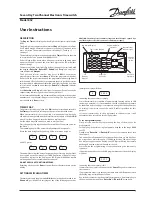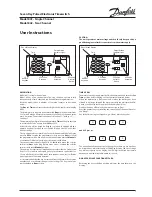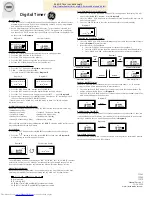
Use and Care Guide
DAYLIGHT ADJUSTING INDOOR DIGITAL TIMER
Figure 3 - Typical Wiring
Schematic for 3-Way Installation
5
1
7
Hot Side
Line
LINE SIDE
LOAD SIDE
C
H
H
5
4
7
C
H
H
Load
In a typical 3-way application there are two 3-way switches. The switch on the “HOT”
side has the common terminal tied to 120VAC. The switch on the “LOAD” side has the
common tied to the lamp/load the switches turn OFF and ON.
2
HOMEDEPOT.com
Please contact 1-866-308-3976 for further assistance.
Figure 2 - Connecting the Tmer Wires for Single Pole Installation
RED
GREEN
BLUE
WHITE
BLACK
TIMER
WALL BOX
LINE
NEUTRAL
LOAD
GROUND
CAP TRAVELER
1
Single Pole Installation
Disconnect the power at the circuit breaker or fuse box
a. Remove the existing switch.
b. Connect the wires of the timer to the wall box as shown, using the wire nuts provided. See Figure 2.
□
Connect the hot/live wire of the line to the black wire from the timer.
□
Connect the hot/live wire of the load to the blue wire from the timer.
□
Connect the ground wire to the green wire from the timer.
□
Connect the neutral wire to the white wire from the timer. Often the neutral (white) wire can be found in the back of the wire box
connected with a wire nut. There may be several neutral wires bound together. Add the timer neutral to all neutral wires bound
together making sure the wire nut is tight.
□
Attach a wire nut to the red (traveler) wire from the back of the timer. This wire is not needed in the single pole installation.
c. Ensure that all wire nuts are secure, and tuck the wires into the wall box, leaving room for the timer.
d. Use the screws (CC) to mount the timer to the wall box, being careful not to crush any wires.
e. Reinstall your wall plate.
f. Turn the main power ON at the circuit breaker.
g. If the timer display does not turn on, disconnect the power at the circuit breaker or fuse box. Swap the black and blue wires on the
timer. Remount the timer and wall plate, then restore power at the fuse box or circuit breaker.
SEE FIGURES 3 & 4 BELOW
NOTE:
The common is typically a dark colored screw on a single pole or 3-way toggle switch.
NOTE:
If you are using your timer to control a fl uorescent lamp, the timer must be installed on a load-side
wiring box.
PREPARING THE SWITCH ON THE LINE SIDE
a. Disconnect the power from the circuit by turning off the circuit breaker or removing the fuse from
the fuse box.
b. Using the Line Side of Figure 3 shown below as a reference, label and remove the line wire (1)
from the common terminal and the Traveler-2 wire (7).
c. Connect the jumper wire (supplied part DD), the line wire (1) from the common terminal C, and the
Traveler-2 wire (7) together. You should have three wires connected with one wire nut.
d. Connect the other end of jumper (6) back to the common terminal (C) on the switch. Consider
recording the marking/color coding of the Traveler-1 (5) and Traveler-2 (7) wires so you can tell
them apart for later use.
e. Tuck the wires into the box, leaving room for the switch.
f. Install the switch back into the box.
INSTALLING THE TIMER ON THE LOAD SIDE
a.
Using Figure 3-Load side as a visual guide, remove the load side 3-way switch and the three
wires, labeling the wire on the common terminal as Load (4) and the traveler wires.
b.
Connect the removed LOAD wire (4) to he blue wire of the timer.
c.
Using Figure 4 -Timer on the Load Side as a visual reference for the remaining steps,
connect the Traveler-1 wire (5) to the black (line) wire from the timer.
d.
Connect the Traveler-2 (7) wire to the red traveler wire from the timer.
e.
Connect the white wire from the timer to the white neutral wire (2) from the switch box. The
neutral wires may be bundled in the back of the switch box with a wire nut, and there may
be several neutral wires bound together. Add the neutral to all neutral wires bound together,
making sure the wire nut is tight.
f.
Connect the green wire from the timer to the ground wire (3) in the switch box.
g.
Tuck the wires into the switch box, leaving room for the timer.
h.
Use the supplied screws to install the timer, being careful not to crush or pinch the wires.
i.
Restore power at the circuit breaker or fuse box.
j.
If the light fi xture does not operate properly, disconnect the power at the circuit breaker or
fuse box. Then swap the line wire (1) and traveler wire (5) on the timer.
k.
Verify that the light fi xture turns ON and OFF when you manually turn the timer ON and OFF.
Perform this test with the remote switch in both positions. You should hear the timer relay
click ON/OFF. If you hear the relay click but the light fi xture does not turn ON/OFF properly,
check your wiring.
SEE FIGURES 3 & 5 BELOW
NOTE:
The common is typically a dark colored screw on a single pole or 3-way toggle switch.
NOTE:
If you are using your timer to control a fl uorescent lamp, the timer must be installed on a load-side wiring
box.
PREPARING THE SWITCH ON THE LOAD SIDE
a. Disconnect the power from the circuit by turning off the circuit breaker or removing the fuse
from the fuse box.
b. Using the Switch on the Load Side of Figure 3 shown below as a reference, label and remove
the load wire (4) from the common terminal and the Traveler-2 wire (7).
c. Using Figure 5 as a visual reference, connect the jumper wire (6 (supplied part DD)), the load
wire (4) from the common terminal (C), and the Traveler-2 wire (7). You should have three wires
connected with one wire nut.
d. Connect the other end of the jumper (6) back to the common terminal (C) on the switch.
Consider recording the marking/color coding of the Traveler-1 (5) and Traveler-2 (7) wires so
you can tell them apart for later use.
e. Carefully tuck the wires into the switch box leaving room for the timer.
f. Install the switch back into the box.
INSTALLING THE TIMER ON THE LINE SIDE
a. Using Figure 3 shown above - Line Side, as a visual guide, remove the line side 3-way switch
and wires, and label the wire removed from the common terminal (C).
b. Using Figure 5 below - Timer on Line Side as a visual guide, connect the line wire (1) to the
black wire from the timer using the supplied wire nuts.
c. Connect the white wire from the timer to the neutral wire (2) (white). The neutral wires may be
bundled together in the back of the box, and there may be several neutral wires bound together.
Add the neutral to all neutral wires bound together, ensuring the wire nut is tight.
d. Connect the traveler-1 wire (5) to the red wire from the timer and the load wire (4) to the blue
wire from the timer. Connect the green wire to the ground wire (3) (green or bare wire in box).
e. Carefully tuck the wires into the switch box, leaving room for the timer.
f. Use the supplied screws to install the timer, being careful not to crush or pinch the wires.
g. Restore power at the circuit breaker or fuse box.
h. Verify that the load turns ON and OFF when you manually turn the timer ON and OFF. Perform
this test with the remote switch in both positions.
i. If the load does not operate properly, disconnect the power at the circuit breaker or fuse box. Then
swap the load wire (4) and traveler wire (5). This can be done at the timer or the toggle switch
Figure 3 - Typical Wiring
Schematic for 3-Way Installation
5
1
7
Hot Side
Line
LINE SIDE
LOAD SIDE
C
H
H
5
4
7
C
H
H
Load
In a typical 3-way application there are two 3-way switches. The switch on the “HOT”
side has the common terminal tied to 120VAC. The switch on the “LOAD” side has the
common tied to the lamp/load the switches turn OFF and ON.
2
1
5
6
3
5
7
3
4
GREEN
GROUND
WHITE
BLACK
C
Typical Wiring Digram for 3-way installation
with timer on load side
Load
Line
RED
RED
BLUE
BLUE
SWITCH ON LINE SIDE
TIMER ON LOAD SIDE
Figure 4 - Connecting the Timer Wires for a
3-Way Installation - Timer on Load Side
2
1 = Line
2 = Neutral
3 = Ground
4 = Load
5 = Traveler 1
6 = Jumper
7 = Traveler 2
C = Common
terminal
2
1
5
3
4
TIMER ON LINE SIDE
Line
GREEN
WHITE
BLACK
RED
RED
BLUE
BLUE
Typical Wiring Digram for 3-way installation
with timer on line side
Figure 5 - Connecting the Timer Wires for a 3-Way
Installation - Timer on Line Side
1 = Line
2 = Neutral
3 = Ground
4 = Load
5 = Traveler 1
6 = Jumper
7 = Traveler 2
C = Common
terminal
2
4
5
6
3
GROUN
SWITCH ON LOAD SIDE
D
Load
C
2
Load Side 3-Way Installation Instruction
Item #469-637
Model #49814
UPC #043180498144
3
Line Side 3-Way Installation Instruction
Please reference page 1 to identify the right installation method for your timer and basic wiring terms.






















